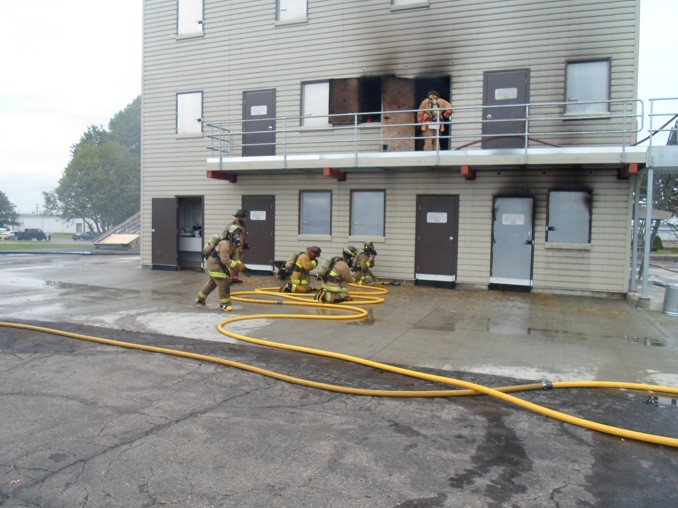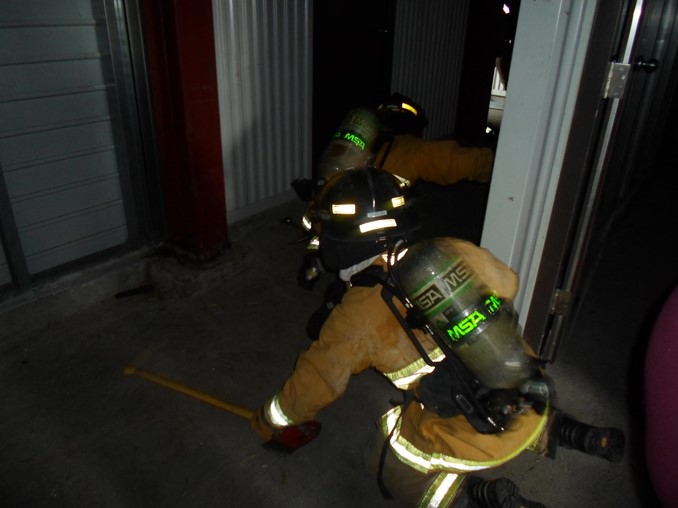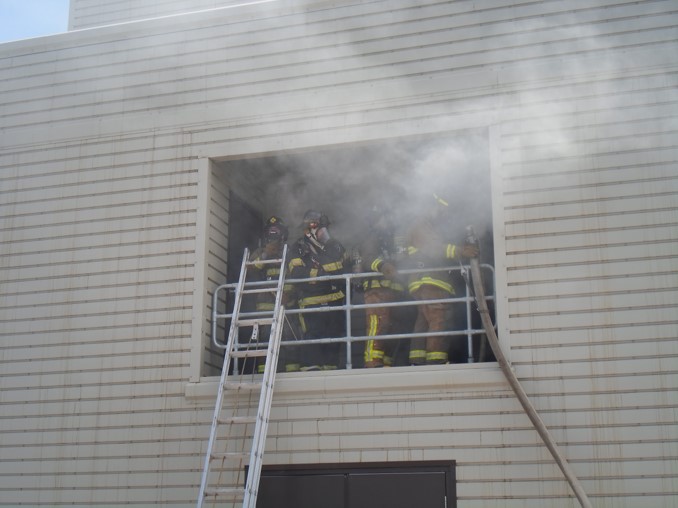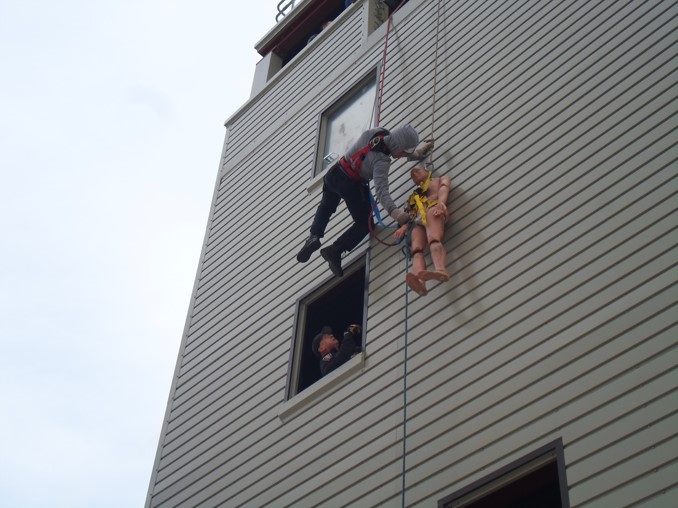
Source: Fire Facilities, Sponsored Content
After about 20 years of service at the Great Oaks Fire Academy in Cincinnati, OH, it was abundantly clear that the burn structure for live fire training and the adjunct tower needed to be replaced. The commercially made structure wasn’t hiding its age or the punishment it had received over the years.
“We were beginning to question the integrity of the other building because of its age,” says Jonny Mason, the fire safety services supervisor at the academy. “To us, it just didn’t age that well.”
Mason and his approximately 100 instructors and board of directors began the process of looking for a new training structure for live fire training and other scenarios when they learned of Fire Facilities, a maker of high-quality steel fire training towers and steel training buildings located in Sun Prairie, WI.
Mason says a committee, of which he was a member, worked on finding a new fire training facility for about 10 years. “We first saw a Fire Facilities building on a trip we were on for a Department of Defense class we took, and we kept an eye on that company. We wanted to get it 100 percent right the first time.”
The committee started researching and talking with other users and quickly learned that the live fire training buildings and towers Fire Facilities manufactured were durable and easy to use.
“As an Air Force guy myself, in fire protection, I had to learn more about Fire Facilities,” Mason says. “If the Air Force buys them, and they are happy with them, there has to be something good, and we needed to dig a little deeper.” Mason is a former career firefighter with 28 years of active service, having retired from the Liberty Township (OH) Fire Department as a lieutenant. Previously, he worked as a captain with the Woodlawn (OH) Fire Department. He continues to serve as a fire captain with his local volunteer department. He has a bachelor’s degree in education and associate’s degree in fire science and was named to the Ohio Fire Service Hall of Fame as the Ohio Fire Instructor of the Year in 2016.
As Great Oaks Fire Academy was going through the process of researching and specifying the firefighter training facility, the Tyndall Air Force Base on the Florida Panhandle took a direct hit from Hurricane Michael which virtually obliterated all the structures on the base. One notable exception was a Fire Facilities training structure, which stood tall while everything around it had been ravaged by the October 18, 2018 storm.
“It was an identical tower to ours, but it was 20 years old,” Mason says. “When I pointed that out to the staff, they were like, ‘Awesome.’”
Durability and high-quality were two key requirements for Great Oaks, Mason says. With literally hundreds of students using the facility each year, the academy needs something to endure the repeated use and remain safe, he adds.
Every year, the academy has about 50 adult students go through the full 18-week firefighter certification course and as many as 150 high school students during the school year using the facilities, he says, noting that high school juniors typically complete Firefighter I certification and seniors come back for Firefighter II certification.

The academy hosts numerous three- and four-day classes for up to 200 firefighters from the region each year, Mason says, noting that personnel from all of southwestern Ohio, Indiana, and northern Kentucky participate.
With the rigorous uses the training academy was expected to have, Mason says maintenance was an important component in making decisions on what kind of structure to purchase.
Previously, Great Oaks had a live burn facility that required staff to install flame-resistant panels before each use. “I am the only full-time person in the fire academy,” Mason says. “Knowing that we had burns scheduled and we’d have to install the [panels] and we’ve got to pull the maintenance guys in that we’ve trained from doing some other important projects, just to get the building ready, it became something we really needed to evaluate.” The academy staff did its homework and went to Fire Facilities knowing what it was looking for, Mason says, adding the building committee wanted something that was low maintenance. Some other training structures required chemical treatments for live fire training such as a two-part waterproofing process that would, necessarily, cut into the burn time and cost more in labor and maintenance costs.
“We figured that if could cut our maintenance time and expense, we could put more in the building,” Mason says. “That, in itself, was worthwhile.”
The Fire Facilities system for burn structures became attractive because of the lower maintenance, Mason says. Fire Facilities uses Westec insulating systems where the steel structure is protected by a nonasbestos, fire-resistant, blanket-like material that is covered by stainless steel, insulating the structures framework from the high temperatures experienced during live fire training, he says, adding the structure is always ready to go with very little preparation. Previously, the staff had to get the burn panels out of storage, hope none were damaged, and then install them before the structure was used–a labor-intensive process, Mason says.
Fire Facilities’ customer service was another extraordinarily attractive selling point, according to Mason, who says he appreciated the company and the work the sales representative, David Tusio, did to make sure Great Oaks got exactly what was needed.
“They deserve credit for patience and understand where we were coming from,” Mason says. “From a customer service aspect, it was outstanding, even when we started and stopped and started and stopped because of funding and other circumstances.”
Mason says there was never a hard sell on Fire Facilities’ part. “They really didn’t try to oversell us,” Mason says. “It was never like, ‘Tell me what your budget is, and I’ll tell you what you can build.’ That really made a difference to me. We didn’t talk money until after we talked about ideas and what we could do compared to what we needed to do…. The question about budget never came up until we were actually at the end of the process and ready to sign contracts.”
Another aspect of customer service Mason says he really appreciated was there was never an issue that came up that couldn’t be resolved. If the Great Oaks staff asked for something that was “a little crazy,” the Fire Facilities staff would respectfully explain why certain ideas couldn’t be achieved. There was never a feeling of high pressure and false promises just to make the sale, he says.
“If there was an issue, it was addressed,” Mason says. “I just think that is something you don’t see a lot this day and age. He says everyone from the architects to the subcontractors to the construction crews and installation personnel worked together to deliver a quality product.
“There was never a problem that was not solvable in a timely fashion,” Mason says. “Even when something was wrong or needed to be corrected, it was done. It was just a joyful experience because they wanted a quality product to put their name behind and that really showed.”

Even when Great Oaks’ board’s chief executive officer convinced the board at the last minute to erect two buildings instead of one, it wasn’t a problem, Mason says.
The academy had decided to build Fire Facilities’ Chief model as well as the Captain model and had originally joined them together on one footprint. But, on further thought, the board decided that separating the buildings gave the staff more flexibility on how to use the facility. Live burns could be done in the Chief model without interfering with other operations, like rope rescue training, on the Captain model, Mason says. Separating them made a lot of operational as well as construction sense, he says.
“When we pivoted, it didn’t affect Fire Facilities at all,” Mason says. “When asked if we could separate the buildings, they said, ‘Sure, no problem; give us a week, and we’ll have you a new set of drawings.’”
Mason says the decision to separate essentially the hot fire training from the cold training building has already proven a huge benefit.
“We’ve been able to do multiple classes without having to have a scheduling algorithm,” Mason says. “The guys and gals doing rope training, for example, don’t have to worry about smoke blowing in their faces or being shut out of the tower.”
Building two structures instead of just one on the same campus meant the academy never had to shut down its training or travel to another facility to make sure the students got what they needed, Mason says. While the Captain model was constructed on a new footprint on the site, the previous structures could still be used. And when the Chief model for live fire training was completed, the previous training tower and burn building could be demolished and the site cleared with no loss of service.
Great Oaks Fire Academy opened the new Fire Facilities training towers and burn structure for use in May 2021 and spent the first month learning everything they could about the system and its features. Mason says during the “shake-down cruises,” the staff touched off more than 300 live burn evolutions to figure out operating procedures and tweaks on how to do the scenarios as well as to learn all about the safety monitoring systems. “It was a busy month, but, boy, did we get some good training out of it,” Mason says.
Mason says he appreciates the predictability of the new Fire Facilities structures. The built-in safety systems mean the academy staff can give students realistic training in a safe manner.
“If it’s predictable, it’s preventable,” Mason says. “We’ve taken huge steps to have predictable behavior in the building.”
The new burn building mitigates the chance for temperature inversions, and heat saturation on the firefighters and their gear is greatly reduced, he says, noting that the worst incident they’ve experienced so far is a burst hoseline, which had nothing to do with the training buildings.
Realism is important to the academy’s mission, and the new Fire Facilities structure goes a long way to achieving that goal. “Now, we can get into multiple disciplines,” he says. “It’s not just, ‘Let’s light something on fire and put it out and we’ve done live burn training.’ Now, we can throw some ladders and you might actually cut a ventilation hole and ventilate a building.” He adds the system allows for variable smoke conditions from light to heavy.
There are even some built-in features like multiple balconies, both recessed and conventional, and multiple floors with large areas to search. “We have all the different scenarios in one building, in an area that will challenge the new recruits and veteran firefighters as well,” Mason says.
One of the Fire Facilities’ structure features Mason really appreciates is the modular design. They can be customized and expanded as funding becomes available and the need arises.
“That was one of the big selling points,” Mason says. “We didn’t want to be committed to a design in 2020 as our needs might change in 2023. The modular concept allows us to go back and add this option on or that one. When you want to expand, the answer is not, ‘No, you’re stuck with what you’ve got.’”

Among the options Great Oaks choose to start with includes an interior shaft on the Captain tower structure that permits rope operations undercover, out of the weather. The tower also has options to easily create confined spaces scenarios and a roll-up garage door protecting an enclosed space that can accommodate larger props to create more realistic scenarios. Mason says the space will allow for trainees to encounter a forcible entry prop, for instance, inside the smoky enclosed area, creating another environment firefighters might encounter.
Mason says he is really pleased the training tower has a covered penthouse on the top. He says it’s a nice “creature comfort” that makes the learning environment just that much better, offering protection from the beating sunlight or driving rain during rope rescue training.
“I think the only option we didn’t put on was helicopter skids, because I just couldn’t justify them,” Mason jokes. “Believe me, I tried.”
The two Fire Facilities structures were a significant investment for the Great Oaks Fire Academy with a price tag of about $1.3 million in capital dollars, Mason says, noting that the academy already had the land, and the price also did not reflect the demolition of the previous training structures.
“It was a significant investment when all was said and done,” Mason says. “But, when you factor the cost over the course of the expected life of the structures, we’re getting quite the bang for our buck.” Mason says the CEO and board for the academy wanted to do it right the first time and aim for the long-term benefits. “We’re not just meeting the needs of the students today but the students five years down the road, 10 years down the road, and that’s where the flexibility and adaptability came in.” Mason says “the sky is the limit” when it comes to options and configurations for the Fire Facilities’ products.
Mason says he and the academy faculty are thrilled with the new structures. “They love it,” Mason says. “It’s fun watching them be proud of the building, what they are able to accomplish. We have some great, great instructors who work for every kind of department imaginable, from your big city department to rural water supply operations fire departments.”
The instructors have a lot of confidence in the Fire Facilities structure because they helped choose it, watched it being constructed, and appreciate the quality of the equipment. “I like watching them smile at the end of the day,” Mason says of his instructors. “They know they are delivering good training and they know we have really set the standard for safe, live fire training here in our area and the students are protected and the instructors are protected. The training is challenging, but it’s realistic and safe.”
The students themselves are equally pleased with the training structures, Mason says, noting that he’s particularly pleased with the reaction of the academy alumni. “The best feedback is from the former students who trained in the old building,” Mason says. “I call it the ‘wow factor.’ I love listening to them say, ‘I really wish we had this when I was going through.’ When they see just how much we’ve improved, from the basic level recruit training to what we have now, they can see the challenge to make their skills even sharper.”
The new students are impressed too, Mason says. “They just think it’s the greatest thing. They think it’s huge,” he quips.
Students get the advantage of learning from instructors who are also practitioners, Mason says, adding that when the staff encounters something in the real world, they can come into the academy with a new idea, ready for recreating. He says the Fire Facilities buildings are sufficiently flexible to modify and create scenarios from experiences.
“In the training world, you’re always pursuing the ominous words of realistic and relevant for your training scenarios,” Mason says. “I think we are as close to that as you can get and still provide state-of-the art, safe, live burn training …. The buildings are getting used and proving the value for the dollar. The return on investment is going to be exponential over the expected life.”
Mason holds his head high with the completion of the new training buildings at the academy he supervises. He’s proud of the product delivered by Fire Facilities. “Post construction, post opening, the follow up provided by Fire Facilities shows they are genuinely proud of the buildings,” Mason says, noting that the Fire Facilities staff is using the Great Oaks facility for testimonials and is telling everybody what great structures it has. “It’s kind of cool,” Mason says. “A little bit of pride kicks in and we can say we built a really, really good building …. From concept art to final delivery, every step of the way, Fire Facilities was great to work with. We knocked it out of the park, if you ask me.”

CORRECTION (3/18/2022): A previous version of this story had the date of Hurricane Michael as May 31, 2019.

